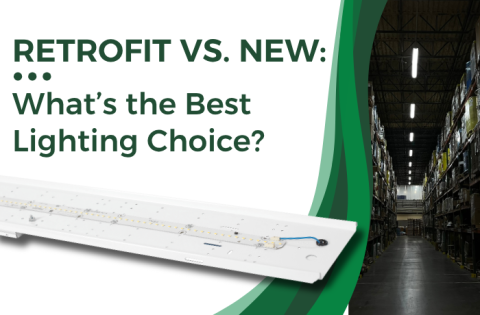
The transition from traditional fluorescent lighting to LED technology isn't just an option anymore; it's practically a given for commercial and industrial spaces. The compelling benefits of LEDs – including superior lighting quality, dramatically higher energy efficiency, and significantly reduced maintenance thanks to their extended lifespans – make the switch an undeniable smart choice.
However, when it comes to upgrading fluorescent fixtures, facility professionals still face a nuanced decision: should you retrofit existing fixture housings with new LED components, or opt for a complete replacement with entirely new LED luminaires? Both approaches offer distinct advantages, and understanding the nuances can lead to more cost-effective and aesthetically pleasing outcomes for your specific project.
The retrofit process typically involves a streamlined approach. This can include stripping out existing fluorescent tubes, lamp holders (often called "tombstones"), ballasts, and associated wiring. New LED light sources, such as LED tubes or magnetic LED arrays, installed. Many modern retrofit kits feature magnetic attachments, eliminating the need for screws and further simplifying installation. The new LED light source is then wired to its respective driver, which might also attach magnetically, and the original diffuser is put back into place. In many cases, this process can take as little as 10-15 minutes per fixture, minimizing disruption to your operations.
To help you navigate this decision, consider the following three crucial factors:
1. Age and Condition of Existing Fixtures
Fluorescent fixtures have been the workhorses of commercial lighting for decades. While their internal electrical components might be obsolete, the metal housings themselves vary significantly in condition. If your existing fixtures are showing obvious signs of age – rust, significant dents, permanent discoloration, or compromised structural integrity – a complete fixture replacement is likely the more prudent long-term solution. Given the exceptionally long lifespan of modern LED luminaires (often 50,000 to 100,000+ hours), investing in a brand-new fixture ensures that the housing matches the durability of the light source, preventing future maintenance headaches related to deteriorating enclosures. Conversely, if the existing housings are in excellent structural and aesthetic condition, a retrofit can capitalize on that existing asset, saving on material and disposal costs.
2. Location and Aesthetic Goals
An LED lighting upgrade presents an opportune moment to elevate the visual appeal of a space. In high-traffic, client-facing areas like retail spaces, main office floors, conference rooms, or lobbies, a complete fixture replacement offers the chance to install sleek, modern LED luminaires that enhance the overall design and ambiance. New fixtures often come with advanced optical designs, integrated controls, and more contemporary aesthetics that can significantly improve light distribution and user experience, contributing to a more modern and inviting environment.
For more utilitarian or lower-traffic areas, such as restrooms, storage rooms, stairwells, back offices, or mechanical spaces, a simple and cost-effective retrofit can be an excellent choice. In these areas, the primary goal is often functional illumination and energy savings rather than aesthetic enhancement, making the speed and lower upfront cost of a retrofit particularly appealing.
3. Cost, Return on Investment (ROI), and Supply Chain Considerations
While the cost gap between retrofitting and full replacement has continued to narrow over the past few years, the financial implications still warrant careful consideration. For large-scale projects, even a small per-fixture saving from a retrofit can add up to substantial overall savings on the material side. It's crucial to obtain detailed quotes for both options, including not just the fixture cost but also labor, disposal fees, and potential downtime. Factor in the Return on Investment (ROI) – while new fixtures might have a higher initial outlay, their superior efficiency or advanced features could lead to faster energy savings payback.
Furthermore, while global supply chains have largely stabilized since the challenges of a few years ago, lead times for highly customized or very large orders of new fixtures can still sometimes be longer than for readily available retrofit components. Retrofitting often allows for a faster rollout, as it reuses existing infrastructure and may involve fewer complex logistics. Evaluate not just the material cost, but also the total project cost, including labor, potential disruptions to operations, and the overall time required to complete the upgrade.
By carefully evaluating the age and condition of your existing fixtures, the specific location and aesthetic goals for the space, and the overall cost, ROI, and logistical implications, facility professionals can make an informed decision that best suits their operational needs and budget when transitioning to LED lighting.